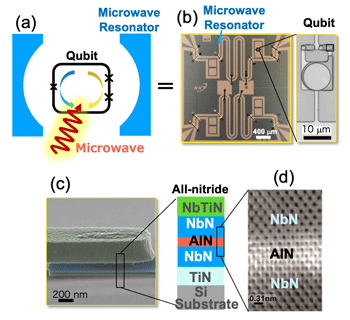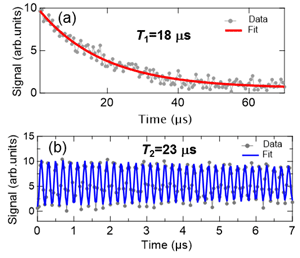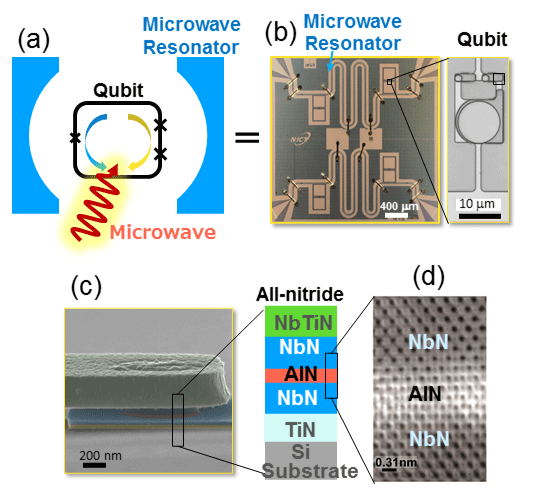Superconducting qubit
A type of qubit (the smallest unit of quantum information used in a quantum computer). A qubit realized by a quantum circuit composed of superconductors is a superconducting qubit that can be used to represent a superposition of state |0> and state |1>.
Epitaxial growth
Epitaxial growth is one of the thin film crystal growth techniques. It is a film formation method in which crystal planes are aligned and arranged on a substrate. For epitaxial growth of NbN, a substrate of MgO single crystal having almost the same lattice constant is generally used, but the MgO substrate has a large dielectric loss in the microwave frequency range, so it is not desirable to use it for qubit fabrication. For reference, the lattice constant of MgO is 0.421 nm, and that of NbN is 0.446 nm. In the case of a high-resistance Si substrate, the dielectric loss is an order of magnitude smaller and suitable for qubit fabrication, but its lattice constant (0.542 nm) is significantly different from NbN, so there is a difficulty in epitaxial growth on the Si substrate. However, NICT has developed an epitaxial growth technology for NbN on Si substrates by using TiN (lattice constant 0.424 nm) as a buffer layer between the Si substrate and the NbN thin film, and has made it possible to apply it to qubits.
Niobium nitride (NbN)
One of the materials that develops a superconducting state in which the electrical resistance becomes zero at a temperature below the superconducting transition temperature. The superconducting transition temperatures of niobium (Nb) and niobium nitride (NbN) are approximately 9 K (-264 degrees Celsius) and 16 K (-257 degrees Celsius), respectively. Niobium nitride, which has a high superconducting transition temperature, has the advantage of requiring less power for cooling.
Josephson junction
An element having a structure in which two superconducting electrodes are separated by an ultrathin insulator or a normal conductive metal thin film is called a Josephson element. It can carry an electric current with zero resistance (zero voltage) due to the tunnel effect between the superconducting electrodes. Since the magnitude of this Josephson current is determined by the difference in the macroscopic phase of both superconducting electrodes (DC Josephson effect), conversely, the amount of current flowing through the Josephson element between the superconducting electrodes can be macroscopic. The phase can be controlled. Many superconducting devices such as superconducting qubits are based on the macroscopic phase control by this Josephson element as the basic operating principle.
Amorphous
Must not be crystalline. There is no regularity in the arrangement of atoms and molecules in the solid, and it is also called amorphous substance.
Coherence time
The lifetime of the quantum superposition state. It is the time during which quantum interference continues between two quantum superposition states. When the coherence disappears, the quantum superposition state is lost, and the state of the particles is fixed to one of the states.
Energy relaxation time (T1) and phase relaxation time (T2)
There are two known qubit coherence times, called energy relaxation time (T1) and phase relaxation time (T2), which characterize the dynamics of a qubit. The energy relaxation time T1 governs how fast the excited state
(|1>), which is obtained by irradiating a qubit in the ground state (|0>) with a microwave pulse called a π pulse, releases energy and returns to the ground state |0>. It is a time that represents the process of relaxation. The probability that a qubit is found in the excited state |1> decays exponentially with time, and its time constant is T1. T2 is called phase relaxation time or lateral relaxation time. A microwave pulse called π / 2 pulse prepares the superposition of state |0> and state |1>, and the time until the phase of the superposition state decays with time is called T2.
Quantum node
Long-distance communication of quantum information is made possible by optical fiber optical communication technology, which enables the construction of quantum networks. However, the problem is that the optical signal becomes weaker as the moving distance becomes longer, and the communication speed is limited by quantum noise and so on. In order to solve this problem, quantum nodes allow the quantum properties of optical signals to be freely measured, controlled, and stored at the relay points (nodes) of this network. A quantum node requires a quantum processor composed of many qubits from one qubit depending on the purpose of use.
Society 5.0
The concept of a future society proposed by Japan is a human-centered society that achieves both economic development and solutions to social issues through a system that highly integrates cyber space (virtual space) and physical space (real space).
https://www8.cao.go.jp/cstp/society5_0/Crystal Orientation
It means that the unit structures (microcrystals) that make up a solid are arranged in a certain direction.
Dielectric loss
When a high-frequency signal (GHz band) is applied to a dielectric, part of the electric field energy of the high-frequency signal is lost due to the thermal energy generated because the phase is delayed from the AC electric field and polarization occurs.
Piezoelectricity
Also called piezo characteristic, when pressure is applied to a certain solid material, it is polarized in proportion to the pressure, and a surface charge appears. Conversely, it also includes the property that a solid material is deformed when an electric field is applied (inverse piezoelectric effect). If a part of the Josephson junction where the electric field is concentrated in the qubit component has piezo characteristics, the coupling between the electric field and the crystal lattice on the substrate side causes energy dissipation on the substrate side due to phonon emission, resulting in fast loss of qubit coherence.



 nict.go.jp
nict.go.jp